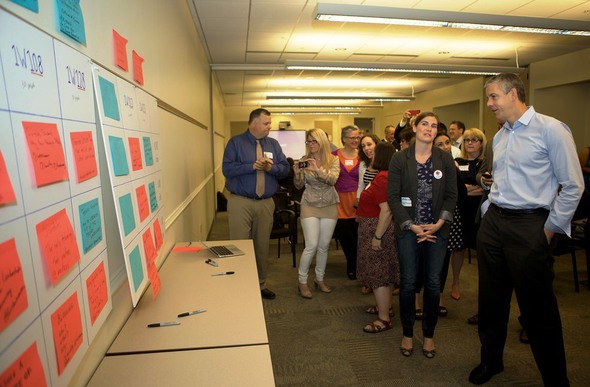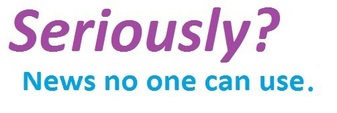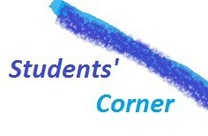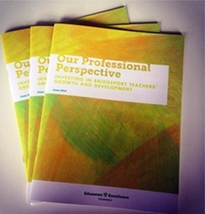June 26, 2014 | Sign up to receive THE TEACHERS EDITION. Note: The Teachers Edition will not be published next week, but the newsletter will return July 10.  Students from P.S. 317 in Queens perform a number from The Jungle Book at New Amsterdam Theater on Broadway. Below, a Disney teaching artist helps a student get in costume for his performance.
THEATER EDUCATION
Students Explore the Great White WayAs teachers, we live for our students' magical moments. Teachers and families in New York recently experienced one of those moments when over 500 elementary and middle school students from nine New York City schools sang, danced, and acted on a Broadway stage to a full house during the Disney Musicals in Schools Student Share Celebration at New Amsterdam Theatre. The event was star-studded: Tony Award-winning actor James Monroe Iglehart hosted the show and First Lady Michelle Obama delivered the opening video message and introduced the first student number, Newsies Get Up & Go.  Disney Musicals in Schools is an outreach initiative designed to develop sustainable theater programs in urban elementary schools. Partnering with individual schools, the Disney Theatrical Group gives them the licensing, resources, and teaching artists who work with the teachers and students to rehearse and produce a Disney musical created expressly for young performers. The experience culminates with a performance on a professional stage. Not only does the initiative provide authentic learning for students and meaningful professional development for teachers, it has lasting impact on the whole community. As Thomas Schumacher, President of Disney Theatrical Group, put it, "The arts make empathetic, collaborative, and creative human beings." Although the program began as a public-private partnership between Disney on Broadway and NYC schools, it has spread to other cities, including Nashville, Seattle, Las Vegas, and Los Angeles. Watch a behind-the scenes video (part 1 and part 2). |
 Arne Duncan dropped by Edcamp to see what the educators were learning from each other. EDCAMP Educators Set the Agenda Earlier this month, the teachers at ED hosted our first #EDcampUSA. "Edcamps" are catching fire as a form of an "unconference" designed specifically for educators. Unlike traditional conferences which have schedules set months in advance by the people running the conference, an Edcamp agenda is created entirely by the participants at the start of the event. Instead of one person standing in front of the room talking for an hour, educators were encouraged to have discussions and hands-on sessions. At this first Edcamp, about 75 educators gathered at the Department and wrestled with ways to use technology to improve learning, among other topics. While there was no set agenda for the day, educators explored three primary themes: policy, ConnectED, and best practice. Interactive conversations were proposed on the morning of the event, honoring every attendee's authentic voice. Check out a complete list of the proposed topics. One of the "Edcampers" from last week, Tom Murray of the Alliance for Excellent Education, wrote a nifty blog offering his five key takeaways from the event. One of our favorites: "It's not about the technology; it's about the learning." Check out the Storify from the event. Speaking of effective uses of technology, check out 30 apps for educators and students posted this week (Devaney, eSchool news).  HUB GOES LIVEConnecting Educators with Resources Preparing America's students with the skills they need to get good jobs and compete with other countries increasingly relies on interactive, personalized learning experiences driven by new technology. Yet fewer than 30% of America's schools have the broadband they need to teach using today's technology. The White House has created a new hub for teachers, students, and administrators to take advantage of the $2 billion in private-sector commitments of free technology for schools. Through this hub, schools across the country will have direct access to free learning software, iPads and MacBooks, teacher training resources, free home wireless broadband, and other educational resources. In June 2013, President Obama announced the ConnectED initiative, designed to enrich K-12 education for every student in America. ConnectED empowers teachers with the best technology and the training to make the most of it, and empowers students through individualized learning and rich, digital content. Under ConnectED, however, 99% of American students will have access to next-generation broadband by 2017. That connectivity will help transform the classroom experience for all students, regardless of income. Check out the new website. |
NCTQ TEACHER PREP REPORT Miles to Go Before We Sleep The National Center on Teaching Quality (NCTQ) released its most recent annual report on the state of teacher preparation programs. The 2014 report indicates that though schools of education and nontraditional pathways are making some progress, as a country we have much more to do to prepare teachers well for the nation's most important work. Though 33+ states have made changes to their laws regarding teacher preparation in the last two years, only seven percent of the 2,400 teacher preparation programs earned a top ranking by the organization. The report ranks the top elementary and secondary prep programs, with Dallas Baptist, Texas A&M, and Ohio State universities leading the elementary programs and Western Governors (Utah), Lipscomb (Tenn.), and Ft. Hays State (Kansas) universities topping the secondary list. Readers may also find rankings for special education and alternative certification programs. There is even a guide to finding classroom-ready teachers and a list of recommendations for states, districts and policymakers. NCTQ's research and reporting strategy is modeled on Abraham Flexner's 1910 review of medical training programs. To determine rankings, the organization takes an in-depth look at admissions standards, course requirements, course syllabi, textbooks, capstone projects, student teaching manuals and graduate surveys, among other sources, as blueprints for training teachers. They apply specific and measurable standards that identify the teacher preparation programs most likely to get the best outcomes for their students, consulting with international and domestic experts on teacher education, faculty and deans from schools of education, statistical experts and PK-12 leaders. Read about education writer Amanda Ripley's take on the teacher preparation conundrum in her article for Slate. Learn about an Arizona State University teacher residency program, called iTeachAZ, that gets high marks from ED (Homeroom).
 Teachers Count Educators and their students can tap into real stories and learn how classroom teachers have changed the trajectory of some of our most visible celebrities, including MVP quarterback Kurt Warner, actor Taye Diggs, and First Lady Laura Bush on a site dedicated to reminding us that behind every famous person is a fabulous teacher. Our only question: when do we get a narrative for Clint Dempsey? The site includes a page of resources for teachers, including information about grants and free posters. |  COMMODORE JOHN RODGERS (Baltimore, Md.)Class Action Commodore John Rodgers Elementary/Middle School is located in an impoverished neighborhood of East Baltimore that struggles with high rates of gang violence and teen pregnancy. In 2010, based on its test scores, Commodore ranked 872 out of 875 schools in Maryland. It enrolled only 225 students, half of the building's capacity. Four principals had come and gone during the previous five years. In the past four years, however, the school's results have measurably improved. Enrollment more than doubled, chronic absences dropped significantly, and the percentage of students proficient in reading and mathematics rose 20 percent. In 2012, the school's mathematics performance exceeded the district-wide average. Learn how the school used resources from the Expanding Great Options initiative and Race to the Top funds to turn it around (Progress). |
 Who Doesn't Graduate (and Where They Live) • Half of the African-American boys who veer off the path to high school graduation do so in just 660 of more than 12,600 regular and vocational high schools. • These 660 schools are typically big high schools that teach only poor kids of color. • They are concentrated in 15 states. (From new research conducted by Robert Balfanz at Johns Hopkins and cited in his NY Times op-ed, "Stop Holding us Back." In his article, Balfanz contends, "Students who don't make it out of high school largely come from our poorest neighborhoods, but the degree to which they are hyper-concentrated in a small set of schools is alarming." Review his research.) Download a Mathematica report on the first year of implementation of School Improvement Grants in 25 schools. Schools reported that when they implemented 11 improvement strategies and actions, all but one improved in some areas. |
 FREE COLLEGE
A College Education Tulsa Students Can Bank On
$19,000. The national average cost of one year of college in 2012. Despite recent measures taken by the President to provide additional student loan relief, many students still cannot afford higher education. To attack this challenge, educators in Tulsa, Oklahoma have presented a seemingly strange solution that makes college possible for them. Tulsa Achieves allows eligible students to attend the first two years of community college for free. So far, 10,000 students have benefited and the results for retention and graduation are promising. Spreading the wealth of this idea, Tennessee plans to follow suit next year, and other states--Oregon, Mississippi and Massachusetts--are considering the possibility. Read the story (Turner and Sanchez, NPR). |
 PRINCIPAL CHATPLC Exemplars and Offenders In this article, Learning Forward's Joellen Killion makes the case that though much of the best professional development comes through educators collaborating in professional learning communities, not all PLCs are alike. "Professional learning communities (PLCs) are hijacked in multiple ways, usually under the pretense of facilitating or supporting the collaboration," Killion writes. "Administrators who dictate the content of collaboration are some of the biggest offenders. Teachers who fail to engage responsibly as professionals with colleagues in collaboration are also offenders." Read the article (Learning First Alliance). |
 WHEN FEAR BECOMES THE ENEMY OF SOLUTIONS. Memphis, Tennessee teacher Jon Alfuth penned this article warning educators not to let "fear with no basis in fact" behind the Common Core backlash to derail efforts to increase the academic rigor in our schools. Read his article (Bluff City Education). TALKING BACK. Second grade Denver, Colo. teacher Austen Kassinger makes insightful observations about the importance of struggling while learning. In the Washington Post, he recounts his own story of wanting to stay home from school when he had difficulty learning to divide during his early years and explains how his mother "would have none of that." Instead, says Kassinger, she "chose not to blame the question, or the teacher, or the test, or the standards. And because of her steady insistence that if I took ownership of my learning, I could master any subject, I recovered from long division and went on to take AP calculus, multivariable calculus and linear algebra in high school." Kassinger urges parents and educators to remember that when school is hard, we should teach students how to solve their problems rather than giving into the temptation to complain or give up. TRUTH IN NUMBERS. More than 200 college presidents and state higher education leaders say the K-12 standards represent a significant improvement over most states' standards. MILITARY LEADERS DEFEND THE COMMON CORE. Retired generals from North Carolina were at the state's Department of Public Instruction last week to encourage the legislature not to derail the Common Core State Standards. The generals said that the standards ensure that students will be better prepared for college, careers and the military, should they choose to serve. Learn more (Stancill, News Observer). "Race is one of those topics in America that makes people extremely uncomfortable. ... [However] the first step to solving any problem is to not hide from it. And the first step to any form of action is awareness." (From a TED Talk given in March 2014, by investment banker Mellody Hobson, "Color Blind or Color Brave?" Check out her inspirational video, which was sent to the teachers at ED by a career counselor at the University of the District of Columbia Community College.)   Less Fighting, More Fear in American High Schools The Centers for Disease Control found in its 2013 National Youth Risk Behavior Survey that there are fewer fights but more fear at high schools. The number of fights between those high school students dropped 42 percent overall from 1991 to 2013, just as the percentage of high school students who stayed home from school because they feared for their safety rose from 4.4 percent to 7.1 percent. Read the report. Learn more (Locke, Vox) OTHER DATA ON SCHOOL SAFETY. In a joint effort, the Bureau of Justice Statistics and National Center for Education Statistics have issued an annual report that examines crime occurring in schools and colleges. This report presents data on crime at school from the perspectives of students, teachers, principals, and the general population from an array of sources, including the National Crime Victimization Survey, the School Crime Supplement to the National Crime Victimization Survey, the Youth Risk Behavior Survey, the School Survey on Crime and Safety, the School and Staffing Survey and the Campus Safety and Security Survey. Learn more. |
 Arne Duncan congratulates a graduate of Salish Kootenai College, a tribal institution primarily serving American Indian students both locally and from across the country. Duncan gave the commencement address at the event. MEETING THE NEEDS OF FIRST AMERICANS Strengthening Tribal Communities Recently President Obama made his first official visit to Indian Country, traveling to Standing Rock Sioux Reservation in Cannon Ball, N.D. During the visit he promised a renewed commitment to American Indian education. Learn more (Morris, Diverse Education). Ahead of the visit, the Department of the Interior announced a plan to improve educational outcomes for Bureau of Indian Education-funded schools, through a series of initiatives to improve education and economic development for Native American communities. Montana Teacher of the Year Anna Baldwin recently visited with folks from ED and the White House to talk about educational challenges facing schools that serve first Americans. Read her blog (The Warrior Trail). Read about how the Executive Director of White House Initiative on American Indian and Alaska Native Education, William Mendoza, discussed preserving tribal languages at Sitting Bull College's Lakhotiyapi Summer Institute. Read Arne Duncan's commencement speech to graduates of Salish Kootenai College. |
 MANAGING STUDENT DEBTTools for Students
More students than ever before are relying on student loans to pay for college education. Today, 71% of students earning a bachelor's degree graduate with debt, averaging $29,400. While most students are able to repay their loans, many feel burdened by debt, especially as they seek to start a family, buy a home, launch a business, or save for retirement. On June 9, to make student loan debt more affordable and manageable, President Obama signed a memorandum directing the Secretary of Education to propose regulations that would allow nearly five million federal direct student loan borrowers the opportunity to cap their student loan payments at 10% of their income. The memo also outlines new executive actions to support federal student loan borrowers, especially vulnerable borrowers who may be at greater risk of defaulting on their loans. Students can get more information from the President's Tumblr Q&A about all things education; a new report, "Taking Action: Higher Education and Student Debt," which contains information on how borrowers are affected in each state; and the White House's "Making College Affordable" website. Read a blog about a town hall Duncan and Undersecretary Ted Mitchell had with students to discuss college affordability (Homeroom). |
 | | TOM MCKENNA (2013 Classroom Fellow) met with rural educators from New Mexico and Colorado (and virtually with educators in Alaska, Arizona, and Mississippi) at the Bread Loaf School of English campus in Santa Fe last week. One of the meetings was attended by representatives from Representative Ben Ray Luján's office, and Senator Tom Udall's office. Among the subjects of discussion: innovative partnerships, professional education, teacher recruitment and preparation, and social and emotional health supports for schools.one. |
PROFESSIONAL LEARNING Investing in Teacher Growth and DevelopmentA team of nine Educators 4 Excellence-Connecticut teachers published recommendations calling on their district to improve professional development after a recent survey indicated that 95% of the teachers believe their professional development is meaningful. The recommendations include calling on the district to make professional development personalized to teachers' needs, and giving teachers opportunities to lead sessions for other teachers. Though their recommendations are for Bridgeport Public schools, the ideas reflect what we hear from teachers across the country. Check out the list. | |  |  MORE THAN ISLANDS IN A STREAM: HAWAII'S ZONES OF PROGRESS. Using Race to the Top funds, Hawaii created two Zones of School Innovation, located in remote, hard-to-staff regions that have the largest concentrations of economically disadvantaged students and some of the lowest-performing schools in the state. Learn more about how the state's investment in teacher training and support, personalized learning, and wraparound services are showing gains in learning and reductions in gaps. ABOUT PROGRESS. ED's Progress blog spotlights state and local innovative ideas, promising practices, lessons learned, and resources informed by the implementation of K-12 education reforms. |
 IN THE WEEDS
For Eduwonks and Insomniacs ED HAS A NEW LOOK. ED's website has a more modern look, with streamlined navigation elements and improved searching. We're now using DigitalGov Search, GSA's free search box solution that allows users to search all of our public-facing content. Learn more. Check out the updated look. RACE TO THE TOP PROGRESS. ED recently released Race to the Top state progress reports for seven states that received grants in the third round of the program: Arizona, Colorado, Illinois, Kentucky, Louisiana, New Jersey and Pennsylvania. These reports capture the highlights of progress and obstacles that the states encountered during the second year of implementation, from January-December 2013. Learn more. Access the reports. |
 Teachers' Notes
• MAKING A DIFFERENCE. ASCD's flagship publication, Educational Leadership, has released a free digital-only summer issue open to all educators. This "Making a Difference" issue celebrates the countless ways educators have a profound effect on students' lives. • WHAT TO MAKE OF THE VERGARA RULING. Watch a CNN Money interview during which Arne Duncan talks with Christine Romans about the judge's finding, saying "I believe in tenure." In this Homeroom blog, Duncan elaborates on his views and argues that, rather than jumping to conclusions and taking sides about the judge's ruling in the Vergara case, educators should make sure they are learning about the complexity of ensuring that all students--including minorities and those with low incomes--get good teaching. Read education reporter John Merrow's take on the decision: namely, that the three California rules being challenged were "indefensible." • DO CHARTER SCHOOLS WEED OUT LOW-PERFORMING STUDENTS? Not according to a new study out of Vanderbilt University. Learn more (Garrison, Tennessean). • INTERVIEW SLAM-DUNK. Teachers looking to advance their careers will appreciate the tips for how to break from popular buzzword patterns and truly impress their interviewers in "Five Things You Think Principals Want to Hear (And What They Really Want to Hear)," (Bohn, ASCD). • HOW TWEET THEY ARE! ED has published social media tip sheets for educators to expand their online engagement. |
LET GIRLS LEARN. Check out this inspiring and informative celebrity video produced by USAID to promote education for girls around the world. Interesting facts are presented, like this one: children of educated mothers are twice as likely to survive past age five. • SUMMER LEARNING FOR TEACHERS OF ENGLISH LEARNERS. ED's Office of English Language Acquisition will offer a series of interactive sessions on July 9 at the Department for the first time. The sessions are accessible through the Internet, and the first will feature a panel of experts who will discuss the new Institute of Education Sciences' What Works Clearinghouse practice guide, Teaching Academic Content and Literacy to English Learners in Elementary and Middle School. For information about how to attend in person or view via mediasite, please contact Anthony Sepulveda (Anthony.Sepulveda@ed.gov; 202-260-0464).  USING DECISION TREES (INSTEAD OF FORMULAS). The Institute of Education Sciences has released a study examining whether the early identification of students who are at-risk for reading comprehension difficulties is improved using logistic regression or classification and regression tree (CART). The comparability of results suggests that practitioners should use CART due to its ease in interpretation and because CART holds several technical advantages over logistic regression. Read the report. |
GETTING WHAT YOU PAY FOR. According to a working paper published by the National Bureau of Economic Research (NBER), in districts that substantially increased their spending as the result of court-ordered changes in school finance, low-income children were significantly more likely to graduate from high school, earn livable wages, and avoid poverty in adulthood. Among the findings: • For low-income students who spent all 12 years of school in districts that increased spending by 20%, graduation rates rose by 23 percentage points; • Between the ages of 25 and 45, these same children were 20 percentage points less likely to fall into poverty during any given year; • Individual wages were 25% higher than they would have been without the changes; and • Family incomes were 52% higher.  NATIONAL PTADuncan Channels his Inner Parent Arne Duncan received a standing ovation and a round of applause after talking with parents at the national convention of the Parent Teacher Association in Austin, Texas, last Friday. In his speech, Duncan shared his aspiration for his own children who are in public schools and discussed his views about hot topics, including rigorous standards, the rising cost of college, school safety, testing, and what it will really take to help children to become lifelong learners. Here are some highlights: On parents' goals for their children: "My daughter, who's in sixth grade, going into seventh, she talked about the chance to be part of a Constitutional Convention – to have that debate, and to learn about the Civil War and again, rather than having to get a lecture, they had a Civil War Day where students, almost like at the college level, they got to pick which class they go to during the day. They had a bunch of different options. "One option was what it was like to be a child during the Civil War, what were children's roles during that time. They had a chance to see their clothing, go in a tent, touch the weapons, and experience those things. They had a mock trial for Mary Surratt, who was maybe, maybe not, an accomplice of John Wilkes Booth – they debated that, and they decided she was guilty. "But it's those kinds of opportunities that I think are so special. And why are those experiences so important? Because I think all of us – all of us as parents – want our children to be inspired, to be challenged, to be active participants in their own learning. "And here's why this matters so much: Every child – every student -- deserves an education that will prepare her for the future. And more and more, success in the real world won't be just about what you know, but what you can do with what you know." On the value of teachers and principals: "Great teachers and great leaders matter more than anything else in school. I think everyone here would agree that we must do even more to respect, reward, and retain them. "We have to stand up for great teachers. We have to celebrate them and create pathways and opportunities for them to shape and nurture the next generation of teacher talent. While we know that, as a nation, we don't always act on those beliefs. If we did, we would provide teachers with better resources. We would pay them a lot more. And we would train and support them better. "Doctors, top managers and pro athletes all have access to excellent coaching, informed by solid data. They receive top-notch training and ongoing development to hone their skills. "Together, let's work to make all those elements the norm in teaching – better training, better resources, better support, and smarter accountability, tied to better information about student progress. "Part of great teaching is personalizing instruction, meeting the needs of 30 or more individual students – that's a huge, complex task. "Let's make sure teachers have access to the technological tools that can help them meet that challenge– and make sure that student data remains secure and private." |
 Recommended Reading LEADERSHIP OPPORTUNITIES THAT SUSTAIN GREAT TEACHING. This article examines research about how a five-year, Knowles Foundation STEM teacher fellowship positively affected teacher capacity and retention. Download Exploring Early Career Opportunities That Support STEM Teacher Growth and Sustainability (Galosy and Gillespie, The Clearinghouse). DIPLOMAS COUNT. Education Week released the latest Diplomas Count 2014 report, investigating the role that student engagement and motivation play in academic success, in general and for high school completion specifically. A companion survey from the publication's research center finds that: • Student engagement and motivation were identified as the most important driver of student achievement, ranking higher than teacher quality and a range of other influences examined; • Only four in ten educators say the majority of students at their schools are highly engaged and motivated; and • Teachers and administrators report facing a broad array of challenges in engaging students, with a lack of parental support and inadequate time and resources among the leading barriers. |
  Top 5 Quotes Wisdom from educators heard by ED 5. Reflecting on the need to equip teachers to be leaders: "Leadership skills are very different from teaching skills." (Teacher, N.J.) 4. "We need to bring a light to the continuum of teaching." (Teacher, Vt.) 3. "In my time teaching Jazz and aesthetics, I have found the most rewarding aspects to be playing music with my students. Watching them grow from their time picking up an instrument to developing the competencies to perform gigs as artisans drives me to be the best educator I can be each and every day." (Teacher, N.Y.) 2. "Ever since childhood when my friends and I used to play school, I always felt comfortable in the classroom. I never really had an 'ah ha' moment. My coming to teaching was more of an evolution." (Teacher, Springfield, Penn.) 1. "It is really nice to have someone come in and witness what it's like in the trenches. ... Every one of my kids has different needs." (Teacher, Washington, D.C.) |
|

No comments:
Post a Comment